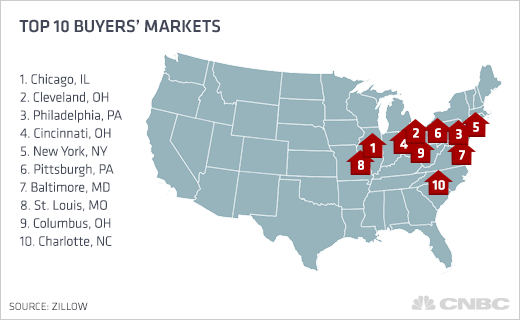
BLOG
Painting Your Own Home: Tips to Make the Process Painless

Painting Your Own Home: Tips to Make the Process Painless
While it’s might seem easier to hire professionals to paint the house, but with a little research you can find the job is not as intimidating as it seems. With a few free days set aside and some preparation, painting one room (or multiple) is easily doable for anyone. Here are a few things to consider before you start.
Apply a Primer Coat
Preparation entails most of the painting process. It’s easy to become frustrated during the preparation stage, because prepping to paint can take longer than the actual painting component of the project.
Interior walls aren’t always perfect, and painting the walls is a perfect opportunity to fix those imperfections. If you’re using a putty or a filler to patch holes, the paint will react differently to those substances than it will the wall itself. The solution here is to prime your walls, so the new paint color has a uniform surface to adhere to. It’s one simple step that doesn’t seem like much, but could end up saving you a whole lot of work at the end of the process.
Factor in taping time
Taping up the room is tedious work, but will be worth it when you don’t have to waste time being ultra-careful or nervous when getting close to edges. Instead of trying to take the tape off while the paint is still dry, wait at least 24 hours for the paint to dry, and use a knife to slice the tape off at the edge. If the paint is still even a little wet or gummy, don’t continue. Make sure the knife is sharp enough and pull the tape away at a 45-degree angle, making sure not to rip the paint.
Set up with clean-up in mind
To protect floors, a drop cloth is a necessity. In some cases, cotton or canvas drop clothes can work better than plastic. Plastic drop cloths can be slippery and don’t easily stay in place, especially when ladders are involved. Any splatters or drips of paint that fall onto a plastic drop cloth won’t dry or absorb right away and can be easily tracked throughout the rest of your house. A canvas or cotton drop cloth will be more stable and will protect the floors better. Tape the edges of the drop cloth to the tops of the trim to protect both the floor and the trims from any splattering or dripping paint.
Work top down
Not only does it prevent drips from ruining anything you’ve already painted, but it keeps the walls and baseboards free of any dust or debris from sticking to wet trim. Paint the ceiling first, move to the walls and possible crown moldings. Only then should you move to any trims around windows or doors and finish with the baseboards. Not only will this keep a system in place to ensure there’s no questioning what’s been painted and what hasn’t, but it’ll keep things clean.
Check thickness of previous paint layers
Cracks on an exterior paint job don’t reflect the owner’s best intentions and should be fixed before the damage is too much to fix. Too thick of a layer of paint means that the paint might just be too heavy to stay, and will start to crack and to peel off. It loses its grip and can’t attach to the other layers of paint. In older homes, it’s likely that some of those layers of paint have lead in them, in which case you’ll need to look into how to remove it safely. The EPA has guidelines here. This could be the one step that requires you to outsource, if the layer of paint is extremely thick, because removing it completely (and correctly) will ensure the next coat of paint will attach correctly. Hiring a home washing company can help you identify these cracks in exterior paint as well. If anything, have the exterior of your home professionally power washed, so the paint will have a clean surface to adhere to.
Using these tips, ideally the house-painting process will be doable for anyone. Prepare yourself to set aside time for set-up, knowing that it will help when you’re done painting and ready to clean up. Instead of hiring painting professionals, save some money for decorating and tackle the job yourself.
Curious to know how much your Southern California home is worth! Get an instant report now! www.CaliOnTheMove.com
Bio: Matt Lawler is an Internet marketing specialist from Tempe, Arizona where he attended Arizona State University. Whenever he can step away from the computer, Matt enjoys playing sports, traveling and exploring the great outdoors. Follow him on Twitter.
Laura Key, REALTOR® Cal BRE 01908085 310-866-8422 Laura.A.Key@gmail.com www.KeyCaliforniaHomes.com
Tree Hugging REALTOR®
This weekend I had a wonderful time previewing homes in Hancock Park. You would think that since I see so many homes with clients the last thing I would want to do on a rare off Sunday is go see more homes! Sometimes you find treasures worth more than gold. Such is the finding of this fabulous tree. This great maze of branches and leaves still lives behind a multi-million fixer upper.
The minute you see this fallen beauty you know it has stories to tell. Children climbing it's branches, picnics under it's once upright limbs. You just don't see things like this everyday. And even though this old tree has fallen, it will still have many stories to tell. I do hope that the new owners leave it right where it is, so it can create future stories for all to wonder at.
There is something so rare, so beautiful and so peaceful about standing beside it. I could not fit the whole tree in a single photo. Look at the first photo, you will see the base and some of it's exposed roots.
Memories, precious memories this tree holds! I feel all the more wiser just for seeing this classic beauty!
Ready to start making memories of your own? Find your new home today! Text LKHOMES to 87778 for your FREE. Or call me today and let's get started on your personal journey! 310.866.8422
Hancock Park, Memories, California Homes, Holiday Joy, Childhood Dreams, Trees, Old Trees, Wisdom, Peace, Peaceful, Joy, Majestic, Realty Goddess, Realtor Goddess, Real Estate Agent, #1 Agent, Windsor Square, Mid-Wilshire
4 Big Drivers of the Housing Market Recovery
There seems to be a light at the end of the tunnel and it's getting brighter each day! Let's Get YOU a home! Laura Key 310.866.8422
The Wall Street Journal highlighted four primary reasons why the housing market recovery is strong. They are:
- Sales have made big leaps from year-over-year levels. Existing-home sales are up 9.7 percent compared to one year ago. Sales are at an annual rate of 4.97 million, which is the highest level since November 2009, according to NAR. Despite constrained inventories and recent price gains, home sales continue to post increases.
- Non-distressed home sales are increasing. Home buyers are showing high demand for non-distressed homes. In April, about 18 percent of sales were in foreclosure or a short sale — down from 28 percent year-over-year.
- Inventories have increased. In April, the number of homes for sale rose 11.9 percent from March. The limited supply — mixed with rising buyer demand — has helped home prices to rise around 10 percent year-over-year. “Rising inventory should ultimately slow some of the price rally while boosting sales volumes, helping to restore equilibrium in the housing market,” The Wall Street Journal reports.
- Homes are selling a lot quicker. About half of all homes that were sold in April were on the market for 46 days, down from 83 days one year earlier, according to NAR data.
Search for your next home FREE! Visit me on Facebook and search NOW!
Source: “Four Reasons Why Home Sales Are Looking Healthy,” The Wall Street Journal (May 22, 2013)
When It Comes to Wood Floors, Choose Wisely
Rich wood flooring can spell instant warmth and patina in a home. Here’s an overview that can help you evaluate if wood floors are right for you! Laura Key 310.866.8422
Just as with ties and hem lengths, wood flooring styles change. Colors get darker or lighter; planks get narrower or wider; woods with more or less grain show swings in popularity; softer or harder species gain or lose fans; and the wood itself may be older, newer, or even pre-engineered with a top layer or veneer-glued to a substrate to decrease expansion and contraction from moisture.
Here are key categories for consideration:
Solid Plank
This is what some refer to as “real” wood because the wood usually ranges from three-eighths to three-quarters of an inch in total thickness to permit refinishing and sanding. Thicker floors have a thicker wear layer to allow for more frequent refinishing and sanding, so they can withstand decades of use, says architect Julie Hacker of Stuart Cohen and Julie Hacker Architects. It also can be stained, come from different species of tree, and be sold in numerous widths and lengths:
- Width and length: Designer Steven Gurowitz, owner of Interiors by Steven G., is among those who prefers solid flooring for many installations because of its rich, warm look. Like other design professionals, he’s seeing greater interest in boards wider than the once-standard 2 ¾ to 3 ¾ inches — typically 5 to 6 inches now but even beyond 10 inches. And he’s also seeing corresponding interest in longer lengths, depending on the species. Width and length should be in proportion. “The wider a board gets, the longer the planks need to be, too, and in proportion,” says Chris Sy, vice president with Carlisle Wide Plank Floors. These oversized dimensions reflect the same trend toward bigger stone and ceramic slabs. The downside is greater cost.
- Palette: Gurowitz and others are also hearing more requests for darker hues among clients in the northeastern United States, while those in the South and West still gravitate toward lighter colors. But Sprigg Lynn, on the board of the National Wood Flooring Association and with Universal Floors, says the hottest trend is toward a gray or driftwood. Handscraped, antique boards that look aged and have texture, sometimes beveled edges, are also become more popular, even in modern interiors, though they may cost much more.
- Species and price: Depending on the preference of the stain color, Gurowitz favors mostly mahogany, hickory, walnut, oak, and pine boards. Oak may be the industry’s bread and butter because of the ease of staining it and a relatively low price point. A basic 2 ¼-inch red oak might, for instance, run $6.50 a square foot while a 2 ¼-inch red oak that’s rift and quartered might sell for a slightly higher $8.50 a square foot.
- Maintenance: How much care home owners want to invest in their floors should also factor in their decision. Pine is quite soft and will show more wear than a harder wood like mahogany or walnut, but it’s less expensive. In certain regions such as the South, pine comes in a harder version known as heart pine that’s popular, says Georgia-based designer Mary Lafevers of Inscape Design Studio. Home owners should understand the different choices because they affect how often they need to refinish the wood, which could be every four to five years, says Susan Brunstrum of Sweet Peas Design-Inspired Interior. Also, Sy says that solid planks can be installed over radiant heating, but they demand expert installation.
Engineered Wood
Also referred to as prefabricated wood, this genre has become popular because the top layer or veneer is glued to wood beneath to reduce expansion and contraction that happens with solid boards due to climatic effects, says Sy, whose firm sells both types. He recommends engineered, depending on the amount of humidity. If home owners go with a prefabricated floor, he advises a veneer of at least one-quarter inch. “If it’s too thin, you won’t have enough surface to sand,” he says. And he suggests a thick enough substrate for a stable underlayment that won’t move as moisture levels in a home shift.
His company’s offerings include an 11-ply marine-grade birch. The myth that engineered boards only come prestained is untrue. “They can be bought unfinished,” he says. Engineered boards are also a good choice for home owners planning to age in place, since there are fewer gaps between boards for a stable surface, says Aaron D. Murphy, an architect with ADM Architecture Inc. and a certified Aging in Place specialist with the National Association of Home Builders.
Reclaimed Wood
Typically defined as recycled wood — perhaps from an old barn or factory — reclaimed wood has gained fans because of its aged, imperfect patina and sustainability; you’re reusing something rather than cutting down more trees. Though less plentiful and more expensive because of the time required to locate and renew samples, it offers a solid surface underfoot since it’s from old-growth trees, says Lynn. Some companies have come to specialize in rescuing logs that have been underwater for decades, even a century. West Branch Heritage Timber,for instance, removes “forgotten” native pine and spruce from swamps, cuts them to desired widths and lengths, and lays them atop ½-inch birch to combine the best of engineered and reclaimed. “The advantage is that it can be resanded after wear since it’s thicker than most prefabricated floors, can be laid atop radiant mats, and doesn’t include toxins,” Managing Partner Tom Shafer says. A downside is a higher price of about $12 to $17 a square foot.
Porcelain “Wood”
A new competitor that closely resembles wood, Gurowitz says porcelain wood offers advantages: indestructibility, varied colors, “graining” that mimics old wood, wide and long lengths, quickness in installation, and no maintenance. “You can spill red wine on it and nothing happens; if there’s a leak in an apartment above, it won’t be destroyed,” he says. Average prices run an affordable $3.50 to $8 a square foot. The biggest downside? It doesn’t feel like wood since it’s colder to the touch, Lynn says.
Bottom Line
When home owners are making a choice or comparing floors, Sy suggests they ask these questions:
1. Do you want engineered or solid-based floors, depending on your home’s conditions?
2. Do you want a floor with more natural character, or less?
3. What board width do you want?
4. How critical is length to you in reducing the overall number of seams?
5. What color range do you want — light, medium, or dark?
6. Do you want more aggressive graining like oak or a mellower grain like walnut?
7. Do you want flooring prefinished or unfinished?
8. How thick is the wear layer in the floor you’re considering, which will affect your ability to refinish it over time?
9. What type of finish are you going to use? Can it be refinished and, if so, how?
10. For wider planks that provide greater stability: Where is the wood coming from, how is it dried, what is its moisture content, and what type of substrate is used in the engineered platform?
Thinking of selling your home? A little investment can increase your resale value! Call me for a personal consultation! Laura Key 310.866.8422
Does HUD Offer Special Programs for Homebuyers?
Buying a HUD Home is not as difficult as you may think! I have helped many people purchase their 1st Home from HUD! Call me today for more details about the process! Laura.A.Key@gmail.com or Visit my website to sign up for FREE HUD Listings! http://www.KeyCaliforniaHomes.com
Yes, HUD offers a program called the GOOD NEIGHBOR NEXT DOOR PROGRAM for Police Officers, Firefighters, EMT and Teachers! Call for more details on this program! 310.866.8422. If foreclosures are not sold within six months, HUD will sell them for $1 each to approved nonprofit organizations and government agencies. Homes must then be used create housing for families in need or to benefit neighborhoods.
Los Angeles HUD homes, Buying A Hud Home, North Hollywood HUD homes, Westchester HUD Homes, Gardena HUD Homes, Northridge HUD Homes, Santa Clarita HUD Homes, Simi Valley HUD homes, Lemert HUD Homes, Compton HUD Homes, Lynwood HUD Homes, Hawthorne HUD Homes, Inglewood HUD Homes, Baldwin Hills HUD Homes, Playa del rey HUD homes, Marina del Rey HUD Homes, Santa Monica HUD homes, Lakewood HUD homes, Buying A HUD Home, Buying a Los Angeles HUD Home, HUD Trained Agent, HUD NAID agent, Good Neighbor Next Door
Does HUD Offer Financing On Their Homes?
Buying a HUD Home is not as difficult as you may think! I have helped many people purchase their 1st Home from HUD! Call me today for more details about the process! Laura.A.Key@gmail.com or Visit my website to sign up for FREE HUD Listings! http://www.KeyCaliforniaHomes.com
HUD does not provide direct financing to buyers of HUD Homes. Buyers must obtain financing through either their own cash reserves or a mortgage lender. If you have the necessary available cash or can qualify for a loan (subject to certain restrictions) you may buy a HUD Home. While HUD does not provide direct financing for the purchase of a HUD Home, it may be possible for you to qualify for an FHA-insured mortgage to finance the purchase.
Los Angeles HUD homes, Buying A Hud Home, North Hollywood HUD homes, Westchester HUD Homes, Gardena HUD Homes, Northridge HUD Homes, Santa Clarita HUD Homes, Simi Valley HUD homes, Lemert HUD Homes, Compton HUD Homes, Lynwood HUD Homes, Hawthorne HUD Homes, Inglewood HUD Homes, Baldwin Hills HUD Homes, Playa del rey HUD homes, Marina del Rey HUD Homes, Santa Monica HUD homes, Lakewood HUD homes, Buying A HUD Home, Buying a Los Angeles HUD Home, HUD Trained Agent, HUD NAID agent
Do I Need An Appraisal On A HUD Home?
Buying a HUD Home is not as difficult as you may think! I have helped many people purchase their 1st Home from HUD! Call me today for more details about the process! Laura.A.Key@gmail.com or Visit my website to sign up for FREE HUD Listings! http://www.KeyCaliforniaHomes.com
It is not necessary to have a HUD home independently appraised, HUD offers an appraisal every 6 months. Your Lender may require a more current appraisal than the one provided by HUD. Ask your loan officer or HUD registered agent.
Los Angeles HUD homes, Buying A Hud Home, North Hollywood HUD homes, Westchester HUD Homes, Gardena HUD Homes, Northridge HUD Homes, Santa Clarita HUD Homes, Simi Valley HUD homes, Lemert HUD Homes, Compton HUD Homes, Lynwood HUD Homes, Hawthorne HUD Homes, Inglewood HUD Homes, Baldwin Hills HUD Homes, Playa del rey HUD homes, Marina del Rey HUD Homes, Santa Monica HUD homes, Lakewood HUD homes, Buying A HUD Home, Buying a Los Angeles HUD Home, HUD Trained Agent, HUD NAID agent
How Much Money Will I Have to Put Down on a HUD Home?
Buying a HUD Home is not as difficult as you may think! I have helped many people purchase their 1st Home from HUD! Call me today for more details about the process! Laura.A.Key@gmail.com or Visit my website to sign up for FREE HUD Listings! http://www.KeyCaliforniaHomes.com
If the bid price is less than $50,000, you’re required to make an earnest money deposit of $500. HUD homes priced greater than $50,000 require a $1000 deposit.
Los Angeles HUD homes, Buying A Hud Home, North Hollywood HUD homes, Westchester HUD Homes, Gardena HUD Homes, Northridge HUD Homes, Santa Clarita HUD Homes, Simi Valley HUD homes, Lemert HUD Homes, Compton HUD Homes, Lynwood HUD Homes, Hawthorne HUD Homes, Inglewood HUD Homes, Baldwin Hills HUD Homes, Playa del rey HUD homes, Marina del Rey HUD Homes, Santa Monica HUD homes, Lakewood HUD homes, Buying A HUD Home, Buying a Los Angeles HUD Home, HUD Trained Agent, HUD NAID agent
Making an Offer On A HUD Home?
Buying a HUD Home is not as difficult as you may think! I have helped many people purchase their 1st Home from HUD! Call me today for more details about the process! Laura.A.Key@gmail.com or Visit my website to sign up for FREE HUD Listings! http://www.KeyCaliforniaHomes.com
Buyers will want to make offers based on ‘as-is’ appraisals determined by HUD. HUD will accept no offers that are lower than 50 percent of their appraisal. If you offer more than the appraisal price, you will be required pay the amount of the over-bid at closing, as your lender will base their loan amount on the appraised value of the home. Also, the process is a bit different than a regular offer on property. Your offer will be submitted online and government forms will be used to conduct the transaction.
Los Angeles HUD homes, Buying A Hud Home, North Hollywood HUD homes, Westchester HUD Homes, Gardena HUD Homes, Northridge HUD Homes, Santa Clarita HUD Homes, Simi Valley HUD homes, Lemert HUD Homes, Compton HUD Homes, Lynwood HUD Homes, Hawthorne HUD Homes, Inglewood HUD Homes, Baldwin Hills HUD Homes, Playa del rey HUD homes, Marina del Rey HUD Homes, Santa Monica HUD homes
Housing Shortage Will Dampen Spring Market
Buyers must be prepared more than ever! Do you have your PRE-APPROVAL in hand? It could mean the different of you getting your new home or renting for another year. Call me, let's discuss your options! Laura Key 310.866.8422
The housing recovery is progressing, but a shortage of homes on the market will limit the number of home sales this spring selling season, industry insiders say.
"If we don't see more people listing their properties, I don't think we will see the home sales volume increase that we are accustomed to seeing," Glenn Kelman, chief executive officer of Redfin told Reuters. "There are far more buyers than there are sellers on the market. We would have a huge boom spurred by low interest rates if there were more inventory on the market."
Still, the National Association of REALTORS® predicts existing-home sales will rise around 7 or 8 percent this spring compared to year ago levels.
In some areas where inventories are particularly constrained—like Washington, D.C., New York, and several California cities—homes are selling within hours of being placed on the market.
"The demand for properties is insane. The bidding wars that are going on, there is not enough inventory and it has become truly a seller's market again," says Neil Garfinkel, real estate attorney at Abrams Garfinkel Margolis Bergson in New York.
Source: “Analysis: Supply crunch to take steam out of home sales,” Reuters (April 3, 2013)
When Can I Bid on a HUD Home?
Buying a HUD Home is not as difficult as you may think! I have helped many people purchase their 1st Home from HUD! Call me today for more details about the process! Laura.A.Key@gmail.com or Visit my website to sign up for FREE HUD Listings! http://www.KeyCaliforniaHomes.com
Owner occupants can offer a bid on a HUD home during the first nine days. HUD will look at all bids on the 10th day and decide based on which offer gives them the highest net profit. If there are two or more bids at the same net to HUD the offers will go into a lottery and the bid will be awarded based on chance. After the 10th day if there aren’t any acceptable bids there will be an additional 20 days of bidding where bids are opened and reviewed daily for owner
Los Angeles HUD homes, Buying A Hud Home, North Hollywood HUD homes, Westchester HUD Homes, Gardena HUD Homes, Northridge HUD Homes, Santa Clarita HUD Homes, Simi Valley HUD homes, Lemert HUD Homes, Compton HUD Homes, Lynwood HUD Homes, Hawthorne HUD Homes, Inglewood HUD Homes, Baldwin Hills HUD Homes, Playa del rey HUD homes, Marina del Rey HUD Homes, Santa Monica HUD homes
Who Can Buy A HUD Home?
Buying a HUD Home is not as difficult as you may think! I have helped many people purchase their 1st Home from HUD! Call me today for more details about the process! Laura.A.Key@gmail.com or Visit my website to sign up for FREE HUD Listings!http://www.KeyCaliforniaHomes.com
Almost anyone! If you have the cash or can qualify for a loan (subject to certain restrictions) you may buy a HUD Home. HUD Homes are initially offered to owner-occupant purchasers (people who are buying the home as their primary residence). Following the priority period for owner occupants, unsold properties are available to all buyers, including investors.
Los Angeles HUD homes, Buying A Hud Home, North Hollywood HUD homes, Westchester HUD Homes, Gardena HUD Homes, Northridge HUD Homes, Santa Clarita HUD Homes, Simi Valley HUD homes, Lemert HUD Homes, Compton HUD Homes, Lynwood HUD Homes, Hawthorne HUD Homes, Inglewood HUD Homes, Baldwin Hills HUD Homes, Playa del rey HUD homes, Marina del Rey HUD Homes, Santa Monica HUD homes
Does Moving Up Make Sense?
Don't get caught up in the madness of the market. Deciding to sell is a personal decision, take everything into account. I am here to assist! Laura Key 310.866.8422
These questions will help you decide whether you’re ready for a home that’s larger or in a more desirable location. If you answer yes to most of the questions, it’s a sign that you may be ready to move.
- Have you built substantial equity in your current home? Look at your annual mortgage statement or call your lender to find out. Usually, you don’t build up much equity in the first few years of your mortgage, as monthly payments are mostly interest, but if you’ve owned your home for five or more years, you may have significant, unrealized gains.
- Has your income or financial situation improved? If you’re making more money, you may be able to afford higher mortgage payments and cover the costs of moving.
- Have you outgrown your neighborhood? The neighborhood you pick for your first home might not be the same neighborhood you want to settle down in for good. For example, you may have realized that you’d like to be closer to your job or live in a better school district.
- Are there reasons why you can’t remodel or add on? Sometimes you can create a bigger home by adding a new room or building up. But if your property isn’t large enough, your municipality doesn’t allow it, or you’re simply not interested in remodeling, then moving to a bigger home may be your best option.
- Are you comfortable moving in the current housing market? If your market is hot, your home may sell quickly and for top dollar, but the home you buy also will be more expensive. If your market is slow, finding a buyer may take longer, but you’ll have more selection and better pricing as you seek your new home.
- Are interest rates attractive? A low rate not only helps you buy a larger home, but also makes it easier to find a buyer.
Home Prices Pick Up at Fastest Pace in 7 Years
Sellers, if you were on the fence about selling your home, this should help you make the right decision! Call me for a FREE CMA on your home! Laura Key 310.866.8422
Home prices nationwide, which includes distressed sales, soared 10.2 percent year-over-year, according to CoreLogic’s February report. It’s the largest year-over-year increase in home prices since March 2006. It also marks the twelfth consecutive monthly increase in national home prices, according to CoreLogic’s report.
When excluding distressed sales, home prices rose 10.1 percent year-over-year in February, according to CoreLogic.
“Nationally, home prices improved at the best rate since mid-2006, marking a full year of annual increases and underscoring the ongoing strengthening of market fundamentals,” says Anand Nallathambi, president and CEO of CoreLogic.
CoreLogic predicts that home prices -- excluding distressed sales -- will likely rise 11.4 percent year-over-year from March 2012.
“The rebound in prices is heavily driven by western states,” says Mark Fleming, CoreLogic’s chief economist. “Eight of the top ten highest appreciating large markets are in California, with Phoenix and Las Vegas rounding out the list.”
The five states with the highest price appreciation as of February 2013, according to CoreLogic, were:
- Nevada (+19.3%)
- Arizona (+18.6%)
- California (+15.3%)
- Hawaii (+14.6%)
- Idaho (+13.5%)
Source: CoreLogic
Can I View A HUD Home Before Bidding?
Buying a HUD Home is not as difficult as you may think! I have helped many people purchase their 1st Home from HUD! Call me today for more details about the process! Laura.A.Key@gmail.com or Visit my website to sign up for FREE HUD Listings! www.KeyCaliforniaHomes.com
Can I view a HUD home before bidding?
Sure you can! You must use a HUD registered agent! Properties can be viewed anytime during the bidding process. Just be ready with your loan pre-approval in hand in case you find your dream home. You would hate to miss out because you were not fully prepared!
In A Hot Market...Bid First...See House Later
The market is so hot right now it seems the only way to even have a chance at purchasing a home is to put your offer in a contingency to view and inspect the property. What are your thoughts on this process? Is this creating another false bubble? Laura.A.Key@gmail.com
As soon as it hit the market, the four-bedroom Sea Cliff home inspired a bidding war, with the top two prospective buyers both offering well above the multimillion-dollar listing price, in cash.
In today's fevered real estate market, that's no longer unusual.
But there was a twist: Both bidders were located in China, and both made their big-bucks offers without ever setting foot in the house. One of them ended up buying the house for $3.1 million, substantially above its $2.8 million list price.
"At first, I was really, really surprised and kind of suspicious," said Nina Hatvany of Pacific Union, the listing agent. "I was concerned that they hadn't seen the property. After all, they might not like it when they saw it."
But since both offers looked serious and included proof of funds, "I said to the sellers, 'This seems like a new buyer profile. You might as well take it.' "
Buying homes sight unseen is a small but growing trend in the Bay Area, fueled by the over-competitive market and burgeoning interest by international buyers - and enabled by technological advances.
Buyers might make offers without seeing a house for several reasons: They live elsewhere or are away for business or personal reasons; they had scheduling conflicts and couldn't visit before bids were due; they're investors accustomed to buying just based on property characteristics; or they're taking a scattershot approach of making lots of offers and seeing which get accepted.
Not completely blind
Today's array of tech tools means they're never truly buying in the dark, however. Besides extensive photos and video tours of homes for sale, plenty of websites offer the chance to learn about neighborhoods and schools, and research comparable sales.
Often, those who bid sight unseen have a chance to tour the house during escrow and can still back out. But sometimes, as in the Sea Cliff case, they're willing to pay huge amounts based on photos, videos and their agent's recommendation. (The winning Sea Cliff bidder also had a family member visit.)
Professional investor Paul Livson of Danville has been buying and selling properties for 30 years, both for rental income and to resell. Bidding before visiting is a tactic he and others increasingly adopt, he said.
"Lots of people are doing it now because they know they need to get their offer in quickly," he said. "The market conditions are such that if you wait to see it, if it's any kind of decent deal, there are already five to 10 offers on their way, and yours will be at the back of the pack. I need to be at the front of the pack."
And while he bids blind, he never buys blind.
"The risk is limited because you have an inspection period, so there's always an opportunity to see it and walk away" if it's not up to snuff, he said.
Still, there can be surprises. He's now buying a Pleasanton condo for $279,000. When he first saw the unit - after his offer was accepted - some issues surfaced: cigarette odors, marred floors, outdated bathrooms. Since it's a short sale, in which a bank has final say, it will be difficult to negotiate the price down based on the unit needing work, he said.
But he won't walk away. "With market conditions the way they are, it's still a good value for me," he said.
Riskier deals
Some sales, such as courthouse auctions that are the final stage in the foreclosure process, don't offer a chance to see properties in advance, nor is there an inspection period. While many investors bid at those auctions, "that's much more risky to me," Livson said. "I don't like to buy without having at least a day or two to inspect it. You could have a property that looks great on the outside but has $50,000 worth of termite damage.
His agent,said she's increasingly representing investors who want to bid sight unseen for efficiency, and she has created a "buyer concierge" program in response. "We hunt the properties for them," she said.
Some agents worry that such bidders muddy the waters.
"I am concerned about buyers feeling that this is a viable option in competition," said Bebe McRae of the Grubb Co., who has sold some properties to people who bid blind. "I heard seven offers yesterday on (a property) and the deciding factor for the sellers in choosing the winner was all about the confidence they felt in the buyers being able and willing to close successfully. The buyers went to the property on several occasions and also did their inspections prior to writing the offers."
People who have made the leap of faith to bid blind - especially those planning to live in the home - said having a knowledgeable real estate agent is a big plus.
Fernando Filippelli was overseas for business reasons when a Berkeley home came on the market, in a neighborhood he knew he liked.
"I had four different friends visit the property for me. One of them is an architect," he said in an e-mail. "This, plus the fact that (my agent) provided me all types of info, made me feel comfortable to put a bid on the house."
Inspection by FaceTime
Friends and relatives thought Adam Chang and Gwen Liu were crazy when the first-time home buyers made an offer on a Kensington house while they were in Taiwan, visiting sick relatives. Chang had never seen the house in person, although Liu had.
"We did the home inspection over FaceTime, Apple's video-chatting service," Chang said. "Our agent, Mark Biggins (of Redfin), had an iPhone, I had an iPad. I could see how high the ceilings really were. If they said a floor was sloping slightly, I could get a sense that it wasn't that bad. They took me down into the crawlspace. For being halfway around the world, it was great to be able to be virtually present."
The couple returned to the United States a few days before they needed to lift the inspection contingences.
"I was able to make sure everything was copacetic; it was better than I expected," he said. "It was all about taking that leap of faith."
Source: Carolyn Said is a San Francisco Chronicle staff writer.
For-Sale Home Inventories Remain Tight
Inventory levels in 2012 reached an 11-year low and fell yet again last month, further limiting the number of homes for sale nationwide. Inventories of for-sale homes were down by 16.5 percent in January year-over-year, and fell 5.6 percent from December, according to the latest data compiled from Realtor.com. Inventories typically fall in December and January in preparation of the spring buying season.
“But the shortage of homes for sale in a growing number of U.S. markets is maddening for would-be buyers who frequently complain that there aren’t enough good choices,” The Wall Street Journal reports. “Bidding wars are becoming more common.”
At a time when buyer demand is strong, inventories remain constrained as banks slow their pace of foreclosures and home owners delay selling until they regain more equity in their homes.
Metro areas posting some of the largest monthly declines in inventory levels are San Francisco (where inventory levels are down by 21 percent in January compared to December and down 47 percent year-over-year) as well as Seattle (where levels dropped 9 percent from December). The two have also seen some of the largest price increases in the nation. Median asking prices have risen by 16.4 percent and 23.7 percent in those places, respectively.
Source: “Housing Inventory, Already Low, Dropped Further in January,” The Wall Street Journal (Feb. 14, 2013)
If you are in the market for a new home, it would be wise to use an experienced Buyer's Agent to help guide you through the process. Contact Laura Key today for your free consultation on the up's and downs of being a buyer in this changing market! 310.866.8422 or visit www.KeyCaliforniaHomes.com
A Bit About Mold
There are a number of little things to look out for when purchasing a new home. Normally the things to consider includes such things as location, wiring, the condition of the house itself, and several other factors. One of these factors that the home buying public is becoming more concerned with is mold. There are many different types of mold that can occur in a home and lead not only to structural damage, but some health concerns as well. Mold is difficult to find in many homes as it grows exclusively in dark and moist areas that are usually hidden somewhere in the structural areas of the home such as attics and basements. By the time mold shows up in the actual living areas, chances are that it is all through the home.
One of the most likely places for mold to form is anywhere that moisture is improperly vented. Another area of concern is if a home has ever flooded and was not completely or properly cleaned and dried after. Leaky plumbing and basement crawlspaces are other likely candidates. Mold can be a difficult thing to completely get rid of as the only thing it needs to continue growth is an organic material such as wood, and moisture. Both of these items are usually abundant in any home. The most likely was that moisture finds its way into the home is through faulty or leaky roofs and foundations. Both of these areas should be checked over by an experienced mold inspector on a fairly regular basis if there is any worry of mold beginning to grow, or if these has been mold in the past. Mold can be an expensive problem to deal with so be pro-active about looking for it, it can save you money in the long run.
Mold is one of the inspections you will have when purchasing a home. Finding a good inspector will be one of your top priorities when buying a home. Contact Laura Key today to learn more about the Steps to Buying! www.KeyCaliforniaHomes.com
Realty Goddess
'Nightmare On Elm Street' Home On Sale For Over $2 Million
Looking for a horrifying new place? The home from the legendary "Nightmare on Elm Street" movie can be all yours for just a little over $2 million -- and it’s not nearly as creepy as we imagined.
According to the listing by Redfin, the Los Angeles home has four bathrooms, three bedrooms, "designer closets,” and en suite baths. It’s completely modern with hardwood floors throughout and stainless steel appliances in the kitchen.
The current owner told AOL Real Estate that the home really was a nightmare when she purchased it in 2006. "It was the only house on the street that looked beaten up. The pool looked like it hadn't been touched in 10 years -- it was black," Angie Hill told the publication.
Hill has transformed the property into a dream... but the home still boasts the famous red door from the 1984 thriller, and we are half expecting Freddy Krueger to open it.
Maybe this home is a little too frightening for you? Call Laura Key to find your "DREAM HOME" today! www.KeyCaliforniaHomes.com
Is Your Home in a Buyer's or Seller's Market
As the overall housing recovery gains steam, local market divergences are growing wider. That is because one overriding factor —faulty and fraudulent mortgage lending — brought the market down; it will take varied local and national market drivers — jobs, income growth, consumer confidence, increased lending — to bring it back.
And that is why certain markets remain buyers' markets and certain ones have fast become sellers' markets.
Online real estate marketplace Zillow, defines a sellers' market as not necessarily one where prices are rising, but one in which homes sell faster, price cuts occur less frequently and final sale prices are close to or greater than list price.
Zillow ranked the top 30 markets and found that the formerly hard hit markets in California, Arizona and Nevada now rank as the top sellers' markets, which may seem counterintuitive, until you consider who the buyers there are now.
"Much of that strength is driven by investor interest, as many distressed and non-distressed homes are purchased and transformed into rentals," says Stan Humphries, Zillow's chief economist, in the report. "This investor activity is contributing to very low inventory levels, which increases demand and helps drive up prices, particularly for less expensive homes in these markets."
The best buyers' markets are equally surprising, with Chicago, Cleveland and Philadelphia topping the list.
These markets are still plagued by distress, despite the fact that their foreclosure numbers were lower during the worst of the housing crash. Investors are a far smaller share of buyers, as these markets don't offer the sun and leisure opportunities that the sand states do. Home prices are still suffering in these markets under still-tough local employment conditions. All that makes them less desirable for buyers. Stricter mortgage lending standards are also likely playing an outsized role, since most buyers in these markets would be owner-occupants.
The housing crash was the first fully national housing downturn in U.S. history. Usually housing downturns are local, spurred by some local phenomenon. Now that the overall economy is on the upswing, housing return to its roots and rises and falls on local factors again.
Source: CNBC —By CNBC's Diana Olick
Need to know how much your home is worth? Contact Laura Key today for a free Comparative Market Analysis! www.KeyCaliforniaHomes.com











